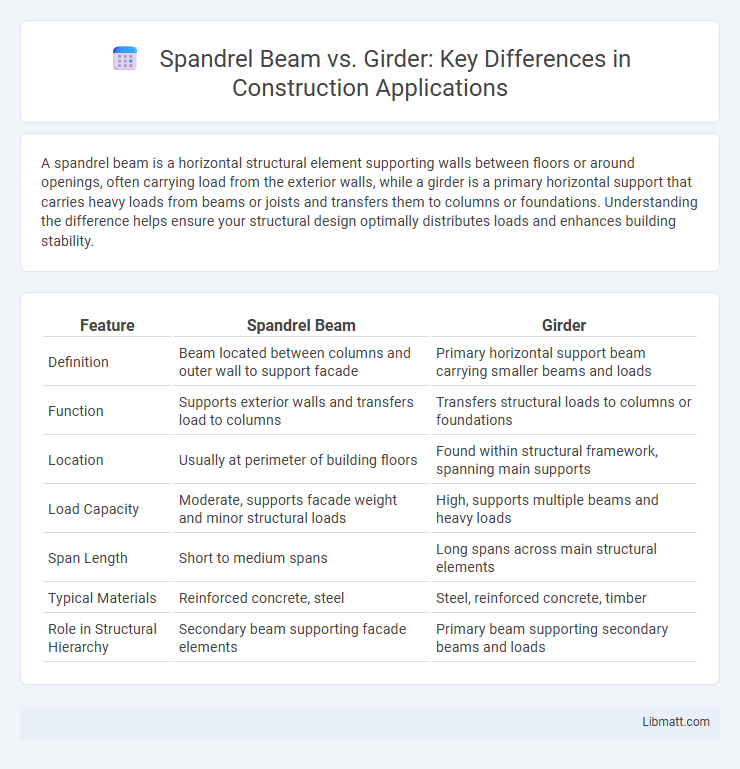A spandrel beam is a horizontal structural element supporting walls between floors or around openings, often carrying load from the exterior walls, while a girder is a primary horizontal support that carries heavy loads from beams or joists and transfers them to columns or foundations. Understanding the difference helps ensure your structural design optimally distributes loads and enhances building stability.
Table of Comparison
| Feature | Spandrel Beam | Girder |
|---|---|---|
| Definition | Beam located between columns and outer wall to support facade | Primary horizontal support beam carrying smaller beams and loads |
| Function | Supports exterior walls and transfers load to columns | Transfers structural loads to columns or foundations |
| Location | Usually at perimeter of building floors | Found within structural framework, spanning main supports |
| Load Capacity | Moderate, supports facade weight and minor structural loads | High, supports multiple beams and heavy loads |
| Span Length | Short to medium spans | Long spans across main structural elements |
| Typical Materials | Reinforced concrete, steel | Steel, reinforced concrete, timber |
| Role in Structural Hierarchy | Secondary beam supporting facade elements | Primary beam supporting secondary beams and loads |
Introduction to Spandrel Beams and Girders
Spandrel beams are horizontal structural elements typically located along the exterior walls of buildings, supporting the loads from walls and transferring them to columns. Girders are larger, primary beams designed to support multiple smaller beams and transfer loads directly to columns or foundations. Understanding the role of both spandrel beams and girders helps optimize your building's structural integrity and load distribution.
Definition of Spandrel Beam
A spandrel beam is a horizontal structural element located between columns, typically supporting the exterior wall and transferring loads from the facade to the main frame. Unlike girders, which are primary load-bearing beams supporting other beams or slabs within the structure, spandrel beams specifically handle lateral loads and help stabilize the building envelope. Your understanding of spandrel beams is crucial for designing efficient building facades and ensuring structural integrity.
Definition of Girder
A girder is a primary structural element that supports and transfers loads from beams and floors to columns or foundations, typically made from steel or reinforced concrete. It acts as the main horizontal support in a building framework, bearing heavy loads and ensuring structural integrity. Unlike spandrel beams, which are secondary and often located along the facade, girders provide critical load-bearing capacity in large spans and complex structures.
Key Structural Differences
Spandrel beams are secondary structural elements that transfer loads from exterior walls or floor slabs to primary beams or girders, primarily supporting cladding or facade components. Girders serve as main horizontal supports, carrying larger loads from multiple beams and transferring them to columns or foundations. Your project's design efficiency depends on understanding that girders handle major structural loads, while spandrel beams mainly support architectural elements and distribute loads locally.
Functional Roles in Building Construction
Spandrel beams serve as horizontal supports that connect columns and support exterior walls or facades, enhancing the structural integrity and distributing loads from the external walls. Girders act as primary beams that carry heavier loads from multiple beams or joists to the columns or piers and are essential for supporting the overall framework of the building. Both components work synergistically to ensure load transfer and stability but differ in scale and specific load-bearing responsibilities within building construction.
Material and Design Considerations
Spandrel beams are typically made from reinforced concrete and positioned between columns to support exterior walls, emphasizing load distribution and architectural integration. Girders, often constructed from steel or prestressed concrete, serve as primary structural members designed to carry heavier loads from beams to columns or foundation. Your choice between these elements depends on the material strength requirements and the structural layout of the building project.
Load-Bearing Capabilities
Spandrel beams primarily support the weight of the exterior wall and transfer loads to the columns, while girders serve as the main horizontal supports carrying significant structural loads from beams to columns or foundations. Girders possess higher load-bearing capacity due to their larger size and robust design, making them critical in distributing heavy loads in multi-story buildings. Understanding the difference in load-bearing roles ensures your structural design optimizes safety and material efficiency.
Typical Applications and Examples
Spandrel beams are commonly used in building facades to support exterior walls and transfer loads from the facade to columns, often seen in multistory structures with curtain walls. Girders serve as primary horizontal supports in bridges and large industrial buildings, carrying heavy loads from beams and distributing them to columns or piers. Your choice between a spandrel beam and a girder depends on the structural role required, with spandrels suited for facade framing and girders ideal for main load-bearing elements.
Advantages and Disadvantages
A spandrel beam offers advantages such as reducing overall building weight and providing better space for window openings, but it has limitations in carrying heavy loads compared to girders. Girders provide superior strength and load-bearing capacity, making them ideal for supporting large spans and heavy structural elements, though they may require more material and space. Your choice between spandrel beams and girders depends on balancing structural needs with architectural design and cost efficiency.
Conclusion: Choosing Between Spandrel Beam and Girder
Choosing between a spandrel beam and a girder depends on the structural role and load distribution requirements within a building framework. Spandrel beams primarily support exterior walls and transfer loads to columns, optimizing facade stability, while girders serve as main horizontal supports that carry significant beam loads and distribute them to columns or piers. Structural engineers select girders for heavier load-bearing needs and spandrel beams for architectural design integration and localized load support.
Spandrel beam vs Girder Infographic

 libmatt.com
libmatt.com